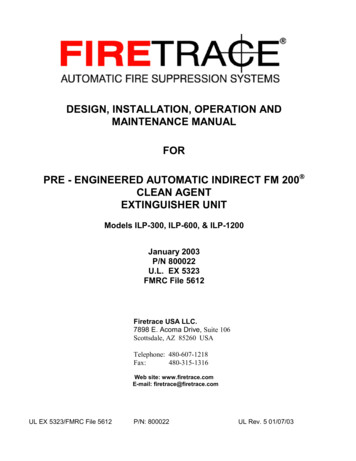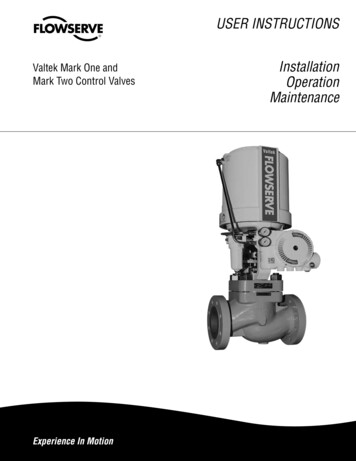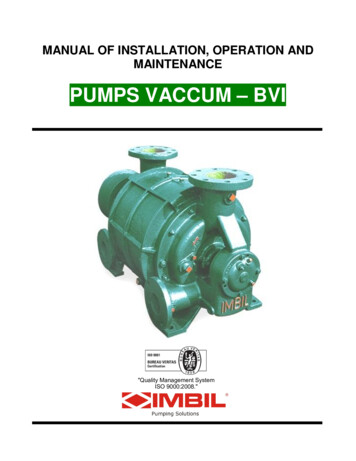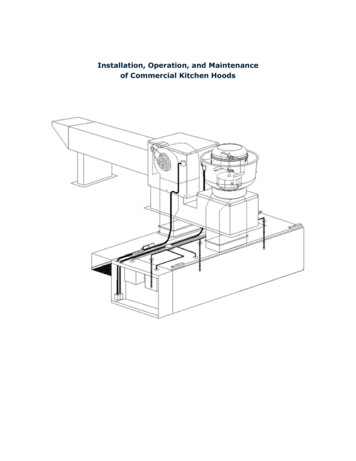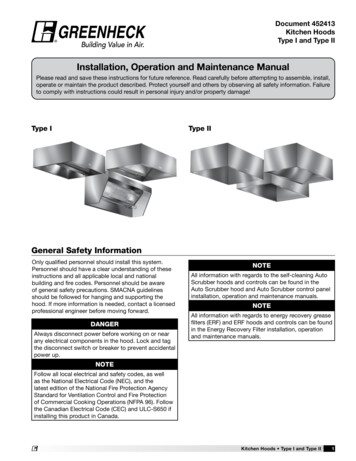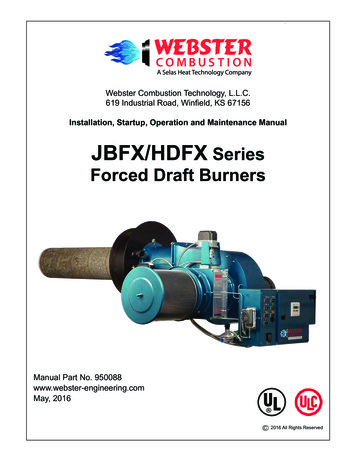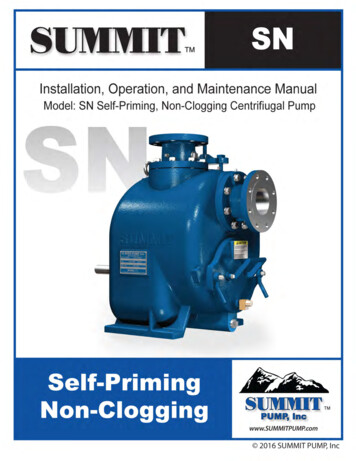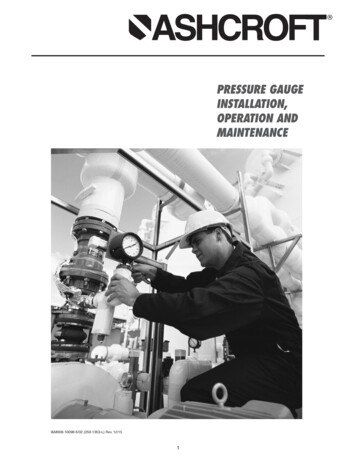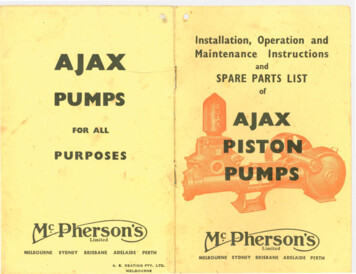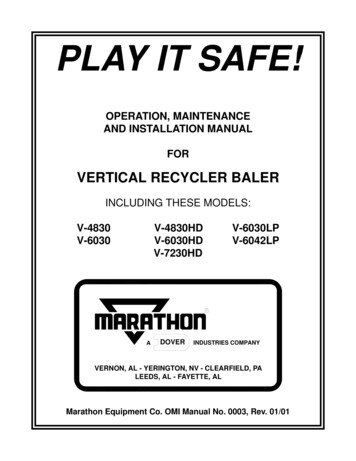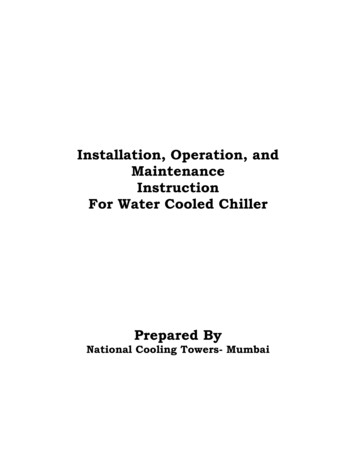
Transcription
Installation, Operation, andMaintenanceInstructionFor Water Cooled ChillerPrepared ByNational Cooling Towers- Mumbai
Installation, Operation, and Maintenance Instruction for Water Cooled ChillerContentContentPrefaceSafety Considerations1 Introduction1.1 Introduction of Nameplate1.2 Characters1.3 Site and Range of Use1.4 Introduction of Structure1.5 Introduction of Refrigeration System1.5.1 Refrigeration Circulating System1.5.2 Oil Circulating System1.6 Introduction of Control System2 Installation2.1 Installation Environment2.2 Site Confirmation2.3 Base Construction2.4 Carrying2.5 Installation2.6 Piping2.7 Wiring2.8 Cold Insulation3 Debugging and Trial Running3.1 Prepare for Debugging3.1.1 Prepare the Documents3.1.2 Prepare the tools3.2 Inspection before Debugging3.2.1 Inspection of Installation Status3.2.2 Inspection of Water System3.2.3 Load Inspection3.2.4 Wiring Inspection3.3 Debugging and Trial Running4 Maintenance4.1 Daily Start and Stop of the Unit4.2 Maintenance of Main Parts4.3. Contaminant Release4.4 Stop of the Unit in Winter4.5 Start of the Unit in Spring4.6 Replacement of Components4.7 Leak and Supplement of Refrigerant4.8 Anti-freezing4.9 Others5 Troubles ShootingWater Cooled Chiller Manual-1-3-4-6-6-7-7-8- 10- 10 - 11 - 12 - 14 - 14 - 15 - 15 - 17 - 18 - 19 - 21 - 23 - 24 - 24 - 24 - 24 - 24 - 24 - 25 - 25 - 26 - 26 - 32 - 32 - 32 - 32 - 33 - 33 - 33 - 33 - 34 - 36 - 38 -Page 2
Installation, Operation, and Maintenance Instruction for Water Cooled ChillerPrefaceIn order to operate the water-cooled screw chiller correctly and reach the expected runningeffect, please read this specification carefully. The following explanation is made herebybefore the operation specification:1. This specification is applicable to all types of National Chiller water-cooled chiller,including the installation, use, operation and maintenance of the unit. For the operationspecification of microcomputer control, please refer to National Chiller2. Please read this specification before installing and using the unit. If there is any question or puzzle,please contact our sales department of commercial & Industrial Chiller.3. In order to use this series of unit safely, please make sure to operate according to the requirement ofCautions for Safety.4. It is necessary to make records during the operation so as to find out the using status and the reasonof malfunction.5. Please make sure that this specification is kept directly by the operator and maintainer.6. In case of any running failure due to malfunction, please contact our sales departmentof commercial & Industrial Chiller according to the following requirements:(1) The nameplate content of the unit (part number, cooling capacity, code and exfactory date)(2) Malfunction status (explain the state before and after malfunction in details,)7. Each unit of this series is inspected and tested strictly before delivery. In case anydamage due to improper disassembly and inspection, or even inability to run normally,please do not disassemble and inspect the unit by yourself. If it is necessary todisassemble and inspect the unit, make sure to contact with our sales department ofcommercial air conditioner and disassemble and inspect the unit according to theinstruction of our professional staff.Safety ConsiderationsIt is safe and reliable to operate National Chiller Water-cooled chiller underthe designed conditions. When operating this unit, it is a must to take some safetymeasures so as to prevent from injury and damage.Before operating National Chiller water-cooled chiller, all the staff involved inon-site installation, running and maintenance should read this specificationcarefully and ensure that you understand and conform to the correct steps.Danger Avoid leak of refrigerant during debugging and use of this unit. Theacceptable density of gassy refrigerant in air (AEL) for human body is1000ppm, in which situation there is no harm for human body. However, ifthere is a great amount of leak, the gassy refrigerant will gather near thefloor, which will cause oxygen deficit. Before the gassy refrigerant isdischarged, do no approach the polluted area in case of harm to human body.Do not clean the pipe or pressurize the unit with oxygen or compressed air.Do not maintain the unit when it is energized.Do not close valves of any safety device.Do not use the test pressure exceeding specified value. Confirm theacceptable test pressure by referring to the designed pressure on thenameplate.No frame cutting or welding on the evaporator and condenser is allowedduring running of the unitWater Cooled Chiller ManualPage 3
Installation, Operation, and Maintenance Instruction for Water Cooled ChillerWarning It is better to use specialized sucking and charging device when charging therefrigerant into or sucking the refrigerant from the unit. The refrigerantdrawn from the unit should be stored in the tank that conforms to designedpressure of the unit and that is designed and manufactured according torelated standard of pressure contain.Do not discharge the refrigerant directly into the air or sewer. No directcontact between liquid refrigerant and the skin or eyes to avoid frostbite ofskin or eyes.The contact of refrigerant and naked frame will produce poisonous gas.Confirm the refrigerant type before charging it into the unit. Wrong chargingwill lead to malfunction of the unit.Inspect the safety device such as safety valve at least once every year. If theenvironment is corrosive, it is necessary to increase the inspection frequency.Once the safety valve is found to be corroded, replace it instead of repairingit.CautionDo not move the unit with fork truck.Do not tread on the pipes of the unit. Otherwise, it will lead to distortion ofthe pipe or leak of refrigerant. Use the same type of parts when repairing the unit. Inspect each valve, connector and pipe to check if they are corroded, rusted,leaked or damaged. Do not loosen the screws before completely discharging the water in the pipe. Water Cooled Chiller ManualPage 4
Installation, Operation, and Maintenance Instruction for Water Cooled Chiller1 IntroductionThis unit is designed, manufactured and inspected according to VaporCompression Cycle Water-cooled Unit for Commercial Use and Industrial Use. Ifthere is any alternation, execution would be subject to the new standard.For the main technical parameters, please refer to the nameplate of the unit.This unit should be used according to related standards of pressure container.1.1 Introduction of NameplateThe name plate is on the left side of the electric control cabinet.NCP-1005- WCNATIONAL CHILLING PLANTTon of Refrigeration(Cooling Capacity)Water Cooled Chiller1.2 Characters1. High efficiency, cramped construction, small size, low noise, large cooling capacity, longlifespan, easy operation2. Adopt widely used, high efficient, reliable and stable twin compressor. The cost ofrunning and maintaining is greatly less than other types of chiller.3. The flooded evaporator enables the distribution of the refrigerant to be more even sothat temperature pattern is optimized and the evaporating temperature is largelyincreased. Meanwhile, the heat exchange efficiency will be improved. Integrated with highperformance and reliable compressor, the cooling capacity and EER is greatly improved.4. The unit is controlled by the microcomputer control system. Stepless capacityregulation is automatic based on the variation of load. The compressor will start at lowload. Between the lowest load and the highest load, stepless capacity regulation isavailable. During the increase of the load, the output and the load maintain best matchingso that highest efficiency and energy-saving running is realized.5. Safety protection functions include anti-phase protection, overload protection, antifreezing protection, high and low pressure protection, exhaust high temperatureprotection, and water flow switch protection.1.3 Site and Range of UseNational Chiller water-cooled chiller can be used for offering cool water of air conditioningsystem and integrating with terminal Industrial unit such as Plastics Industrial andcombined Process Chiller to constitute various Industrial Chilling system. It can be usedfor Chilled Water in sites such Industrial cooling, Process chilling, hotel, hospital, mall,office building and place of entertainment.Range of use: Ambient temperature 45 6Water Cooled Chiller ManualPage 5
Installation, Operation, and Maintenance Instruction for Water Cooled ChillerItemEvaporatorCondenserMax.Min.Inlet water temperatureOutlet water temperatureDifferential temperature between inlet and outletInlet water temperatureOutlet water ifferential temperature between inlet and outlet8*C3.5*CSpecification of use range If the inlet water temperature of evaporator is lower than the value shown in theabove form, it is necessary to reselect the model. Please contact National Chiller. If the outlet water temperature of evaporator is lower than the value shown in theabove form,it is necessary to add antifreeze into the circulating water system. Please contact NationalChiller to buy low-temperature air conditioner.1.4 Introduction of StructureNational Chiller water-cooled chiller is mainly composed of semi closed twin Compressor,shell and tube condenser, flooded evaporator, oil separator, throttle mechanism, electriccontrol system and so on.1 EvaporatorDuring running of the unit, the evaporator maintains low temperature and pressure sothat the evaporated refrigerant takes away the heat of the cooling water.2 CondenserDuring running of the unit, the condenser maintains high temperature and pressure sothat the cooling water flowing throw the condenser will take away the heat of therefrigerant.3 CompressorIt will push the evaporated refrigerant in the evaporator to the condenser and maintain thedifferential pressure of the system.4 Oil separatorIt will separate the refrigeration oil from the gassy refrigerant and send it back to thecompressor so that the compressor runs safely and reliably.5 Electric control systemAdopting microcomputer control system, it is possible to adjust the output coolingcapacity automatically to meet the users actual needs. It is possible to use side, heatsource water pump and cooling tower fan. Displayed parameters include inlet and outlettemperature of cooling water, inlet and outlet temperature of cool water, evaporating andcondensing pressure ect. It is possible to check the current malfunction and the previousmalfunction record. Please refer to instruction of display for detail.Water Cooled Chiller ManualPage 6
Installation, Operation, and Maintenance Instruction for Water Cooled ChillerFig1-1 Appearance of single system unitFig1-2 Appearance of dual system unitSheet3-1 Components of National Chiller water-cooled screw chillerMark1234NameElectric control let cooling waterOutlet cooling waterInlet chilled waterOutlet chilled waterNote: the picture is for reference only. Actual matter is the standard.1.5 Introduction of Refrigeration System1.5.1 Refrigeration Circulating SystemWater-cooled screw chiller is a kind of vapor compression refrigerator. It works byenergizing the refrigerant vapor via the compressor so that the pressure and temperatureincrease. Then it is turned to liquid refrigerant of low pressure and temperature bycondensing and throttling. When it is evaporated in the evaporator, it obtains heat fromthe surrounding (cooling medium, such as cool water) to decrease the temperature of theWater Cooled Chiller ManualPage 7
Installation, Operation, and Maintenance Instruction for Water Cooled Chillercarrier so that artificial refrigeration is realized. Therefore, vapor compression refrigerationcycle includes the four necessary processes of compression, condensation, reducingexpenditure and evaporation. The principles are detailed as below:Outlet cooling waterInlet cooling waterCondenserOil separatorExpansion DeviceCompressorOutlet chilled waterInlet chilled waterEvaporatorFig.1-3 Diagram of refrigeration circulating system for National Chiller water-cooled screw chillerCompression: after the refrigerant vapor in the evaporator is inhaled by the Compressor,the electromotor increases its energy via the rotor of the compressor so that the pressureof refrigerant vapor is increased and it then it enters the condenser. At the same time, thetemperature of refrigerant vapor will increase correspondingly after compression.Condensation: the high-pressure and high-temperature refrigerant vapor fromcompressor will release heat in the condenser via the cooling water in the pipe. Meanwhileit will be condensed into liquid under the saturation pressure (the correspondingcondensation pressure for condensation temperature). In that case, the temperature ofcooling water will increase. The temperature of cooling water is directly related to thecondensation temperature (condensation pressure).Reducing expenditure: when the high-pressure and high-temperature liquid refrigerantfrom the bottom of condenser flows through the throttle device, its pressure will decreaseand it will bulge, with both pressure and temperature decreasing. Then the low-pressureand low-temperature liquid enters the evaporator.Evaporation: the low-pressure and low-temperature liquid refrigerant turns to gas byderiving energy from the cooling carrier (e.g. cool water). At the same time, thetemperature of cooling carrier decreases and the artificial refrigeration is realized. Therefrigerant vapor in the evaporator is then inhaled by the compressor for compression. Theprocesses of compression, condensation, reducing expenditure and evaporation will repeatcircularly to realize the refrigeration. The cooling capacity is in direct proportion to thesuction volume. Therefore, the guiding valve is installed in the Compressor for suctionvolume co
4.2 Maintenance of Main Parts - 32 - 4.3. Contaminant Release - 32 - 4.4 Stop of the Unit in Winter - 33 - 4.5 Start of the Unit in Spring - 33 - 4.6 Replacement of Components - 33 - 4.7 Leak and Supplement of Refrigerant - 33 - 4.8 Anti-freezing - 34 - 4.9 Others - 36 - 5 Troubles Shooting - 38 - Installation, Operation, and Maintenance Instruction for Water Cooled Chiller Water Cooled .
